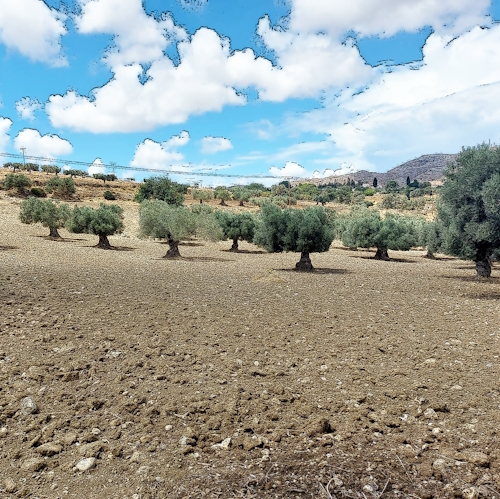COOPERATION FOR THE RESCUE AND TRANSPLANTING OF MONUMENTAL OLIVE TREES IN THE INFRASTRUCTURE CONSTRUCTION AREAS OF THE NEW INTERNATIONAL AIRPORT OF HERAKLION CRETE

The New International Airport of Heraklion is being built in Kasteli, at the Municipality of Minoa-Pediada and will be the new airport of Heraklion city, replacing the existing State Airport of "Nikos Kazantzakis". Work on the construction of the new airport began in 2020, when the concession agreement was officially announced, and is expected to be completed within five years.
The construction of the new airport concerns a total area of 600 hectares; to provide competent accessibility and connection, road works are also being carried out between the northern and southern road axis of Crete, with a total length of 25 kilometers. The location of the project was in a purely rural area, where the olive tree was the main crop throughout time. The change in land use necessitated the deforestation of the Kasteli plain olive groves, which included productive trees of different ages.
A significant number of these "unwanted" trees possessed unique characteristics such as large crown, overall size, particular aesthetics, and trunk imposingness. Based on their morphological characteristics, these trees appear to be very old i.e., "centenarian". The beautiful centuries-old olive trees, which appeared in the concession area individually or in solid olive groves, were the reason for the collective decision to take action to save and relocate them.
Recognizing the feasibility and high value of saving the monumental olive trees in the wider construction area of the new airport, the Decentralized Administration of Crete took the initiative and in June 2021, a Memorandum of Cooperation was signed between D.A.C., the Municipality of Minoa-Pediada and the "Heraklion International Airport of Crete Limited" company. The purpose of the memorandum was to join forces for the rescue, preservation and transplanting of these old olive trees, which would be evaluated as "monumental and worthy of preservation" with scientific criteria and, in the field of works before their uprooting.
The project management team, which was composed for this purpose, recorded, and evaluated in a short period of time all the trees that had special morphological characteristics and appreciable size (Monuments of Nature) in the wider area of the overall works, with scientific contribution from the Hellenic Mediterranean University of Crete. In November 2021 began the preparation and process of uprooting forty (40) historical olive trees with significant cultural and ecological value from the sites of the works, as well as their transfer to a temporary location nearby, until their final transplanting in suitable places at the Municipalities of Minoa and Heraklion.
By joint decision of the contracting parties, the monumental olive trees that are properly cared for in the temporary area at Kasteli, would be transplanted to their final positions both immediately as "landmarks" on selected spots in the city of Heraklion, and soon as the "century-old olive grove" in an open space within the premises of the International Airport, when it starts operating. The choice of sites and the design approach of the transplanting were made with the aim of highlighting the culture of olive cultivation over the centuries in Crete as well as its timeless effect on the formation of the Cretan landscape.
In June 2023 and at the expense of the new airport’s Company, two historic olive trees were transplanted within the city limits of Heraklion and in places where many visitors pass by every day. One of them was transplanted to a green area in front of the "Nikos Kazantzakis" airport building, and the other in a suitable open space along the coastal avenue of Heraklion, east of the Venetian harbor warehouses. In both case-studies, the monumental olive trees of Kasteli are partly surrounded by a stone wall that functions as a flower bed with phryganic species, a seating area, and a receptacle for the lighting fixtures.
This historic olive trees, which are preserved and appropriately transplanted in busy urban areas, testify in the most eloquent way to the importance of olive cultivation in the agricultural production of the island and in the formation of rural societies over time. It is mentioned that historical events on Crete are often revealed through the evolution and image of local olive groves, which constitute the characteristic Cretan olive forest. The project of rescuing the monumental olive trees in the infrastructure construction areas of the new Heraklion International Airport pays tribute to this precious tree and to its cultural and environmental values on Crete.

